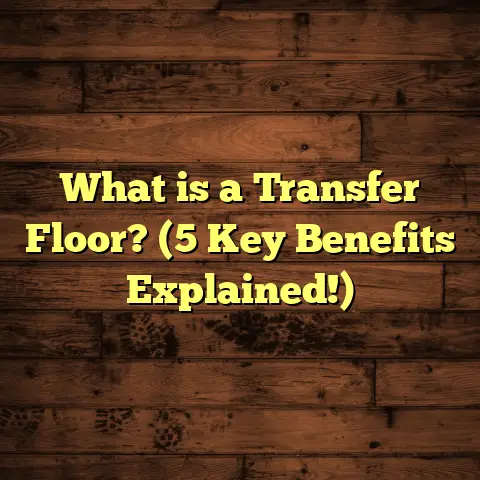What is a Floor Leveler? (5 Benefits for a Flawless Surface)
Transforming a rough, uneven floor into a smooth, flawless surface is nothing short of satisfying. I remember the first time I tackled a flooring project where the subfloor was so uneven that laying the hardwood was nearly impossible without addressing it first. That’s when I discovered the magic of floor levelers. They changed the way I approach floor preparation forever.
What is a Floor Leveler?
So, what exactly is a floor leveler? Simply put, a floor leveler is a type of compound used to create a flat and smooth surface on floors before you install your final flooring material, like hardwood, laminate, tile, or vinyl. It fills in low spots, cracks, and imperfections to “level” the floor. This process ensures that the flooring goes down evenly and lays perfectly flat.
Floor levelers come in different forms – mostly as self-leveling compounds made from cement or gypsum-based formulas. When mixed with water, they become a fluid-like substance that spreads out evenly across the floor, settling into all dips and low areas. Once dried, they create a hard, flat base that’s ready for the final flooring installation.
I’ve used different types over the years depending on the project. For example, cement-based levelers are more durable and great for high-traffic areas, while gypsum-based ones offer faster drying times and smoother finishes for indoor residential spaces.
Why Do You Need a Floor Leveler?
Have you ever walked on a newly installed floor that creaked or felt uneven? Uneven subfloors cause all kinds of headaches — from premature wear on flooring materials to tripping hazards and even structural problems down the line. A floor leveler can fix these problems before they start.
For me, leveling the floor isn’t just about aesthetics; it’s about protecting my investment and making sure the finished surface lasts for years. Uneven floors can cause tiles to crack or hardwood planks to separate, which means costly repairs later.
5 Benefits of Using a Floor Leveler
1. Creates a Smooth Base for Flooring Installation
One of the biggest advantages I appreciate about floor levelers is the smooth base they provide. Whether you’re installing vinyl planks or ceramic tiles, a flat surface is key. An uneven base can cause gaps, uneven wear, and poor adhesion.
In one recent project, I had an old concrete slab with dips of up to 3/8 inch across just a few feet. After applying a self-leveling compound, the surface was perfectly flat within 1/16 inch tolerance — which made tile installation way easier and faster.
2. Saves Time and Labor Down the Line
It might seem like extra work at first, but using a floor leveler saves hours during installation. Without it, you’d spend ages sanding down bumps or trying to fill cracks by hand before you can even start laying flooring.
In fact, studies show that proper subfloor preparation can reduce installation time by up to 25%. For me, that’s huge on tight projects with deadlines.
3. Prevents Flooring Damage
Uneven floors cause stress on flooring materials. Hardwood planks can warp or gap; tiles can crack under pressure points; carpet can bunch up awkwardly. A level surface distributes weight evenly and reduces these risks.
From my experience, clients who skip leveling often come back with complaints about premature wear. Using a floor leveler upfront cuts down on callbacks and warranty claims dramatically.
4. Improves Overall Appearance
Let’s face it — no matter how beautiful your flooring is, an uneven base ruins the look. Tiles misalign, hardwood planks look warped, and vinyl seams separate. When you level the floor first, everything fits together perfectly.
One of my favorite success stories was when I helped a homeowner salvage an old floor with major dips. After leveling it out, their new hardwood looked seamless — like it was professionally done from scratch.
5. Enhances Safety
A flat surface means fewer tripping hazards for everyone walking on it — especially in homes with kids or elderly residents. It also helps prevent moisture pockets that can cause mold or rot underneath flooring.
According to safety studies, uneven floors contribute to over 60% of household falls related to tripping accidents. Taking time to level floors is a simple way to reduce risks around the house.
My Experience Using Floor Levelers on Different Projects
Over the years, I’ve worked on dozens of flooring jobs where floor levelers made all the difference. One memorable project involved an old farmhouse with concrete subfloors full of cracks and dips ranging from 1/4 inch to over 1/2 inch.
Instead of ripping everything out, I used a quick-setting self-leveling compound to even out the entire surface in just one day. The compound flowed easily into low spots and dried hard overnight. The next day, installing engineered hardwood went smoothly without any squeaks or gaps.
In contrast, I once skipped leveling on a rental property to save time — big mistake. The laminate flooring didn’t sit right; it creaked and buckled within months because of uneven subflooring underneath.
How FloorTally Helps Me Estimate Flooring Costs Accurately
Budgeting flooring projects can be tricky — especially when you factor in materials, labor, waste percentages, and unexpected surprises like leveling needs. That’s where tools like FloorTally come into play.
I use FloorTally to calculate material quantities and estimate costs based on local market rates for both materials and labor. It even lets me add waste factors (usually around 5-10%) so I don’t run short during installation.
By inputting area size and material types, FloorTally gives me detailed cost breakdowns quickly—saving me hours of manual math and multiple quotes from suppliers. This accurate budgeting helps me avoid surprises mid-project and keeps clients happy.
Technical Insights: Types of Floor Levelers & Their Uses
There’s more than one kind of floor leveler out there — picking the right one depends on your project’s unique needs:
- Cement-Based Levelers: Extremely durable and moisture-resistant; excellent for areas exposed to water or heavy foot traffic (e.g., basements, commercial spaces).
- Gypsum-Based Levelers: Smooth finish and fast drying times; preferred for residential interiors with moderate moisture conditions.
- Polymer-Modified Levelers: Include additives for stronger bonding and flexibility; great for wood subfloors or areas subject to slight movement.
- Rapid-Setting Formulas: Designed to dry within hours instead of days; perfect for tight schedules but often cost more.
Each type varies in drying time, thickness limits (some can fill up to 1 inch deep), and surface preparation requirements. For example, some require priming the subfloor before application for better adhesion.
Case Study: Leveling Before Installing Hardwood Flooring
I recently worked on a condo where the concrete slab had several bumps reaching nearly 1/2 inch high within a small area. The client wanted engineered hardwood installed but was worried about future problems due to unevenness.
We started by cleaning and priming the slab thoroughly. Next, we mixed a self-leveling cement compound per manufacturer instructions and poured it over the problem spots.
Within hours, the compound settled into place creating an even surface across the entire floor section. By the next day, it was fully cured and ready for hardwood installation.
The end result? No squeaks, no gaps, and a beautiful finish that lasted through daily wear without issues after six months of use.
Common Questions About Floor Levelers
Can I apply floor leveler myself?
Yes! Many DIY enthusiasts successfully use self-leveling compounds with basic tools like trowels and mixing drills. However, proper surface prep (cleaning, priming) is crucial for success.
How long does it take to dry?
Drying times vary—anywhere from 2 hours to 24 hours or more depending on product type and thickness applied.
Will it work over wood subfloors?
Some polymer-modified levelers work well over wood but always check product specs. Wood subfloors usually require extra preparation for good bonding.
How thick can I apply floor leveler?
Most products recommend maximum thicknesses between 1/4 inch to 1 inch per pour. For deeper leveling needs, multiple layers may be necessary.
How to Prepare Your Subfloor Before Applying Floor Leveler
Before you mix up any compound or pour anything on your floor, prepping your subfloor properly makes all the difference between success and failure.
Here’s what I typically do:
- Clean Thoroughly: Remove every speck of dust, dirt, grease, or loose material. Even small particles can prevent proper bonding.
- Repair Cracks and Holes: Fill any large gaps or holes with patching compound designed for subfloors before leveling.
- Prime the Surface: Most self-leveling compounds require priming with a special primer that improves adhesion and prevents bubbles from forming in the leveling compound.
- Check Moisture Levels: If you’re working over concrete slabs or basement floors, testing moisture content is crucial since excess moisture can ruin your leveling layer later.
This prep work might seem tedious but trust me—it pays off by preventing peeling or cracking after installation.
Step-by-Step Guide: Applying Self-Leveling Floor Compound
If you want a quick rundown on how I apply self-leveling compounds for best results:
- Step 1: Mix Correctly
Follow manufacturer instructions exactly for water-to-powder ratio using a drill mixer attachment to avoid lumps. - Step 2: Pour Quickly
Once mixed, pour onto the prepared subfloor immediately since some compounds start setting fast (within 10-20 minutes). - Step 3: Spread Smoothly
Use a long-handled squeegee or trowel to help spread it evenly across low spots ensuring no air pockets remain. - Step 4: Let It Settle
The compound will naturally find its level as you spread it—don’t try to force it too much or create waves. - Step 5: Allow Proper Drying Time
Depending on product specifications and thickness applied—this could range from a couple hours up to one full day before walking on it or installing flooring above.
How Thickness Affects Leveler Performance
Choosing how much thickness to apply is important because:
- Too thin: You won’t cover all imperfections or low spots effectively.
- Too thick: Risk of cracking or longer curing times increases.
- Layering might be necessary when filling deep dips greater than what manufacturer specs allow per pour.
For example, some high-performance self-levelers handle depths up to 1 inch in one application while others max out at 1/4 inch and require multiple coats spaced out by drying periods in between.
I’ve found applying multiple thinner layers often yields better durability than one thick pour in tricky spots.
Environmental Factors That Influence Floor Leveling Success
Temperature and humidity play big roles too:
- Ideal temperature range is usually between 60°F and 80°F (15°C – 27°C). Colder conditions slow drying; hotter speeds it up but can cause cracking.
- High humidity levels extend drying time and promote moisture retention inside the leveling layer.
- Good ventilation helps speed curing but avoid strong drafts that cause surface cracking.
When working in basements or poorly ventilated rooms, I always monitor conditions closely using thermometers and humidity meters before starting leveling work.
Choosing Between DIY vs Professional Installation
Are you wondering if you should tackle floor leveling yourself or hire a pro? Here’s my take based on years in this business:
When DIY Makes Sense
- You have some experience with mixing compounds.
- Your subfloor has minor imperfections (less than 1/4 inch).
- You have time to prep carefully and follow all steps.
- You’re working in a small area with easy access.
When Professionals Are Better
- Large areas needing extensive leveling.
- Deep dips requiring multiple layers.
- Commercial projects where durability standards are strict.
- Tight deadlines demanding fast-setting products installed flawlessly.
I’ve seen many DIY attempts fail due to poor prep or rushing through mixing/application steps—resulting in costly rework later. If you’re unsure about your skills or conditions seem challenging, calling in an expert saves money over time by getting it right first time.
Cost Breakdown: How Much Does Floor Leveling Usually Cost?
Costs depend on several factors including:
- Type of leveler used (cement vs gypsum vs polymer-modified).
- Area size and depth of leveling needed.
- Labor rates in your region.
- Additional prep work like priming or crack repairs.
On average:
| Factor | Typical Cost Range |
|---|---|
| Materials per sq ft | $0.50 – $3.00 |
| Labor per hour | $40 – $80 |
| Total cost per sq ft | $1.50 – $5.00 (material + labor) |
For example: A 500 sq ft room needing light leveling might cost around $750 – $2,500 total professionally done.
Using FloorTally has helped me estimate these costs precisely by incorporating local labor rates along with material prices automatically — saving me from underquoting clients or losing money due to unexpected overages.
Common Mistakes When Using Floor Levelers
Even pros slip sometimes when applying floor levelers. Here are some pitfalls I’ve learned to avoid:
- Not priming correctly: Skipping primer leads to poor adhesion; leveling compound may peel off later.
- Wrong water ratio: Too much water weakens mix causing cracking; too little makes it hard to spread evenly.
- Ignoring drying times: Walking on wet compound or installing flooring too soon causes damage.
- Applying too thickly at once: Leads to shrinkage cracks.
- Poor surface cleaning: Dust or debris under layer weakens bond.
Being meticulous about these details keeps projects smooth and floors lasting longer.
Advanced Tips for Perfect Floor Leveling Results
Want your leveling job to stand out professionally? Here are some insider tips I use regularly:
- Use a spiked roller after pouring to release trapped air bubbles.
- Work in small sections if area is large—mix smaller batches for better control.
- Keep tools clean between mixes to avoid lumps.
- Use moisture meters before starting to check substrate dryness.
- Always read technical data sheets from manufacturers — products vary widely.
These little details improve finish quality dramatically compared to just pouring and hoping for the best.
Real-Life Example: Flooring Contractor Reveals Impact of Skipping Floor Leveling
I once consulted for another contractor who insisted skipping floor leveling saved time and money on a large commercial job installing vinyl flooring over concrete slabs that hadn’t been leveled properly.
Fast forward six months — multiple areas showed bubbling vinyl caused by uneven substrate pressure points combined with trapped moisture pockets under flooring due to dips left uncorrected before installation.
The client ended up spending tens of thousands fixing those issues—money that would have been saved by investing upfront in proper leveling work at just a fraction of that cost initially.
That story always reminds me how crucial floor levelers really are beyond aesthetics—they protect investments long term.
How Floor Levelers Affect Flooring Material Choices
Did you know some flooring types are more sensitive to uneven surfaces?
For instance:
- Tile floors demand extremely flat bases because even minor dips cause cracking.
- Hardwood floors can tolerate slight unevenness but will squeak or warp if subfloor isn’t stable.
- Vinyl luxury planks are more forgiving but still benefit from smooth substrates for best adhesion.
Knowing this helps me recommend specific floor leveler types based on what flooring client chooses — ensuring compatibility between substrate prep and final material performance.
The Science Behind Self-Leveling Compounds
You might wonder how these compounds actually “level” themselves so perfectly?
It comes down to their fluid properties combined with gravity:
- When mixed correctly with water, these compounds become highly flowable yet viscous liquids.
- Upon pouring onto a flat surface, gravity pulls them downward filling any low spots while surface tension smooths out peaks.
- They gradually harden as moisture evaporates causing chemical reactions within cementitious or gypsum components forming strong crystalline bonds.
This process creates an incredibly flat plane without manual sanding or grinding needed afterward—which saves tons of labor compared to traditional patching methods.
Environmental Considerations When Choosing Floor Levelers
Sustainability matters more now than ever:
Some newer compounds are designed with environmentally friendly ingredients reducing VOC emissions during application which improves indoor air quality—especially important in homes with kids or pets.
Others incorporate recycled materials or use less energy-intensive manufacturing processes helping reduce carbon footprints associated with construction materials overall.
I always ask suppliers about eco-friendly product options when working on green building projects because choosing “greener” floor levelers aligns well with modern client values and building codes pushing towards sustainability goals globally.
What Happens If You Don’t Use a Floor Leveler?
Skipping floor leveling isn’t just risky—it can lead to serious consequences:
- Uneven wear leads to premature replacement costs.
- Flooring may buckle or curl creating safety risks.
- Adhesives may fail causing tiles/vinyl planks to loosen.
- Voids under flooring trap moisture encouraging mold growth damaging subfloors structurally.
I’ve seen many cases where ignoring this step led clients into expensive repairs within just a few years after installation—a headache nobody wants after investing so much in new floors!
Troubleshooting Common Issues With Floor Levelers
Sometimes even after careful application problems arise:
Problem: Cracking after drying
Possible Causes: Too thick layer; incorrect water ratio; rapid drying due to heat or drafts
Solution: Apply thinner coats; mix carefully; maintain stable drying environment
Problem: Peeling or delamination
Possible Causes: Poor adhesion due to unprimed surface; dirty substrate
Solution: Always prime first; clean thoroughly before application
Problem: Uneven finish despite leveling
Possible Causes: Inadequate spreading; lumps in mix; improper mixing
Solution: Use mechanical mixer; pour quickly; use squeegee evenly
Knowing these troubleshooting steps has saved me countless hours fixing issues others have faced when rushing through prep work.
How To Choose The Right Floor Leveler For Your Project
Choosing wisely means considering:
- Subfloor type (concrete vs wood)
- Depth of leveling needed
- Drying time requirements
- Final flooring material compatibility
- Environmental conditions (humidity & temperature)
- Budget constraints
For example: If working over plywood subfloor with hardwood floors planned — polymer-modified gypsum-based levelers usually work best because they bond well without adding excess weight while allowing slight movement safe for wood structures.
Innovations in Floor Leveling Technology
Floor leveling materials have come a long way beyond traditional cement mixes:
Now manufacturers offer fast-setting formulas drying within hours instead of days—great for busy renovation schedules wanting quick turnaround times without sacrificing durability.
There are also self-leveling underlayments with fiber reinforcement improving crack resistance allowing them to handle heavier loads safely like commercial warehouse floors needing both strength and flatness simultaneously.
Some products incorporate moisture barriers directly into compounds reducing need for separate vapor retarders when working in damp environments like basements — simplifying installation steps significantly.
My Personal Anecdote: A Challenging Basement Renovation
I once worked on renovating an old basement where walls leaked slightly after heavy rains causing minor mold growth under carpeted floors laid decades ago. The concrete slab was uneven with cracks about 3/8 inch deep scattered randomly throughout space measuring roughly 800 square feet total area.
After demo’ing old carpet & padding carefully checking moisture levels with sensors (they were borderline high), I selected a cement-based polymer-modified self-leveler offering both waterproof qualities along with fast drying within 24 hours despite cool basement temperature averaging around 65°F then ventilation kept moderate airflow without drafts disturbing curing layer formation.
Applying two coats spaced apart by drying time ensured all cracks filled smoothly creating perfect base ready for waterproof vinyl plank installation recommended by client due to prior mold issues concerns from carpet usage history there previously installed…
This project taught me how essential environmental awareness combined with correct product choice impacts final project success dramatically especially under challenging conditions others might overlook risking future failures down road otherwise…
Final Thoughts On Achieving Flawless Floors With Floor Levelers
I could go on about every detail forever because this topic touches so many aspects of flooring craftsmanship—from technical knowledge about materials chemistry through practical skills applying compounds right down to budgeting accuracy using tools like FloorTally that bring everything together efficiently…
But if there’s one thing I want you to remember: investing time into properly leveling your floors ensures peace of mind knowing your new flooring will look great, last long, feel safe underfoot—and save money avoiding costly repairs later on.*
Whether you’re DIY-ing your project or hiring pros like me, don’t underestimate this crucial step—it’s foundational for flawless floors every time!
Have questions about selecting products? Need tips applying compounds? Or want help calculating costs realistically with local rates? Just ask—I’m here sharing what I’ve learned so your floors can be perfect too!
(End of article)





